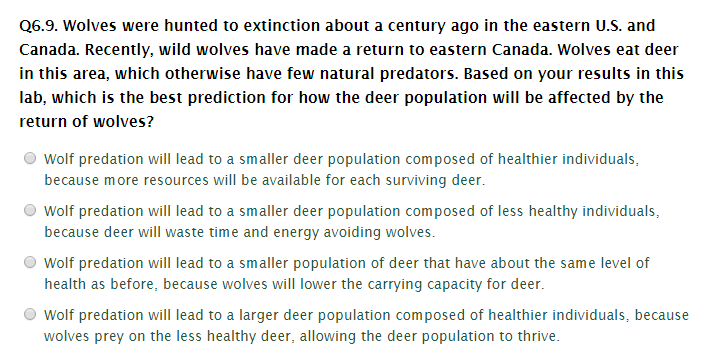Q6.9. Wolves were hunted to extinction about a century ago in the eastern U.S. and Canada. Recently, wild wolves have made a return to eastern Canada. Wolves eat deer in this area, which otherwise have few natural predators. Based on your results in this lab, which is the best prediction for how the deer population will be affected by the return of wolves? Wolf predation will lead to a smaller deer population composed of healthier individuals, because more resources will be available for each surviving deer. Wolf predation will lead to a smaller deer population composed of less healthy individuals, because deer will waste time and energy avoiding wolves. Wolf predation will lead to a smaller population of deer that have about the same level of health as before, because wolves will lower the carrying capacity for deer. Wolf predation will lead to a larger deer population composed of healthier individuals, because wolves prey on the less healthy deer, allowing the deer population to thrive.
Nutrient Cycle
The chemical nutrients that are essential for the synthesis of living matter are taken from the physical environment. After the death and decomposition of living organisms, they are returned to the environment to be used over and again. This cyclic back and forth regenerative movement of chemical elements between organisms and their physical environment is known as the biogeochemical cycle or nutrient cycle. Since these elements serve as the essential chemical nutrients of organisms, their cyclic movements are also called nutrient cycling or mineral cycling. Minerals are not uniformly distributed all over the ecosystems but are more concentrated in specific compartments, called pools. The major biogeochemical cycles include the water cycle, nitrogen cycle, carbon cycle, phosphorus cycle, calcium cycle, sulfur cycle, etc.
Biosphere
The geologist Eduard Sues coined the term biosphere. The biosphere is characterized as a part of the earth, which includes ground and air. Moreover, the organisms on earth live in the biosphere. The biosphere is a confined area on the earth's surface where water, soil, and air combine to promote life. Several different types of life exist here.


Trending now
This is a popular solution!
Step by step
Solved in 3 steps









